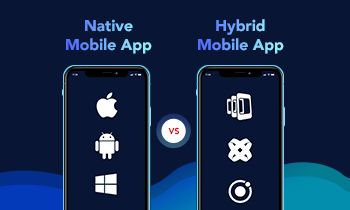How many times you have come across questions like, How technology is reshaping the healthcare industry? How digital healthcare services can improve patient experience? How remote healthcare services can manage your health? Well, everything you heard about technology-enabled healthcare services is 100% true and today, we are going to discuss it in detail.

Indeed, we all are anxious about the severity of the current global crisis! But the fact is that the world has faced several critical global issues earlier, that transcended national boundaries such as Plague, Tuberculosis, Swine Flu, Bird Flu, Dengue, Polio, and inevitable worldwide virus outbreak. During such circumstances, it becomes difficult for people to survive and businesses to sustain as the crisis has an adverse impact on each sector. Bustling metro cities become quiet— empty shopping centers, markets, decimated tourism, and transportation, as well as vulnerable businesses. Amid the crisis, many people with preexisting medical conditions face barriers to survival due to a lack of healthcare services. Despite the inevitable situation, they need to get medical care. Our blog is going to focus on actionable insights to help healthcare providers respond and resolve the queries of their patients during any emergency.
Understandably, most of the healthcare professionals or practitioners struggle to provide treatment to their patients during emergencies. Even clinical operations, surgical schedules, resource utilization, and logistics become challenging to handle. Hence, capitalizing on cost-effective digital healthcare solutions can help all the healthcare stakeholders to continue their quality services during any emergency, because we, as a global citizen, have faced them in the past and will again face if they occur in the times ahead.
Every challenge has a solution, be it a disease or any healthcare emergency, there will be a recovery; we need to be prepared. Considering the importance of technology in the healthcare sector, many healthcare providers are taking advantage of digital healthcare solutions to act in a time of crisis. The use of technology in the healthcare sector has become crucial. Patients and healthcare service providers now have access to digital healthcare tools. Many hospitals from developed nations are using information and communication technology to monitor patients remotely, maintain medical data, diagnose medical conditions effectively, and provide value-based patient care.
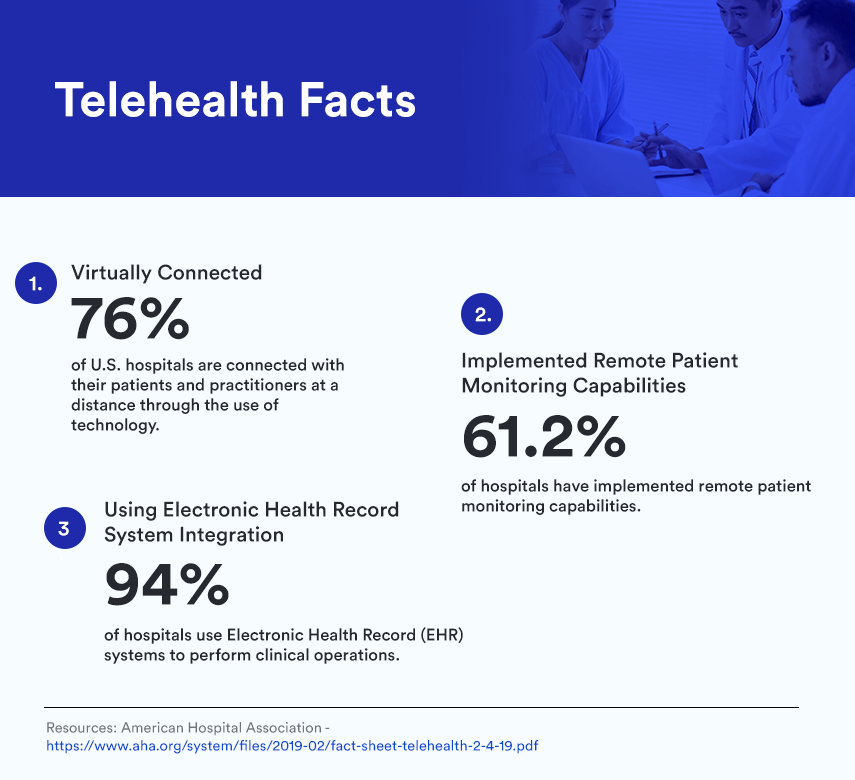
This advanced use of health information technology and telecommunication for better care delivery is known as “Telehealth.” But, it has been a decade, telehealth has become part of the healthcare sector.
Time to Look Ahead for Virtual Patient Care Through Telehealth
Adoption of virtual health care will benefit both the patients and healthcare providers in the longer run. The practice of delivering healthcare services through virtual mode and telecommunication technologies is known as telehealth. It promotes long-distance clinical healthcare and patient education. It is also known as “Online Health”, “Connected Health” or “E-Health”. Remote care, monitoring, and consultation is possible because of telehealth technology. Somehow it is misunderstood with the term “Telemedicine”, that enables only remote clinical care to patients. Telemedicine is a part of telehealth services.
Telehealth technology connects patients with healthcare providers through a broad range of digital healthcare tools like healthcare mobile apps (mHealth), wearable technology, video conferencing, and chat. The healthcare professional can diagnose and treat symptoms through a virtual visit. Telehealth is the best fit for rural areas, in case of lack of mobility, funding, and staff, and during the global crisis to improve patient care.
How Telehealth Service can be Delivered
Defining telehealth delivery modes can help access healthcare services and deliver better patient experience. There are two categories of telehealth service delivery:
Direct to Healthcare Providers
Providing resources for better patient outcomes to healthcare service providers like doctors, specialists, pharmacists, and Insurance providers.
Direct to End Customer – Patients
Promoting services to direct end customers that include remote care, virtual appointments, patient monitoring, and engagement.

Forms of Telehealth: An Enabler of Healthcare Access in Different Forms
As telehealth can be used in multifaceted medical specialties like Dermatology, Radiology, Neurology, Physician, or other fields, it has different forms to provide healthcare services as mentioned below:
1 Remote Patient Monitoring and Engagement
This form allows healthcare professionals to engage with their patients virtually and track their health signs or activities at a distance. Those high-risks patients, who have been released from hospital recently, can be monitored easily. Professionals can monitor a wide range of healthcare data such as blood pressure, glucose level, heart rate, weight, and electrocardiograms.
2 Live Feed and Video Conferencing
This form enables the live interaction between a patient (or caregiver) and a doctor (or professional) using audio-visual communications technology. The live video telehealth technology can be accessible for any healthcare professional consultation or patient engagement. Many hospitals are using this technology to connect emergency healthcare service providers at hospitals for remote ICU monitoring.
3 Real-time Healthcare
This form enables real-time medical care between patients and healthcare professionals anytime, anywhere in the world through telehealth technologies, be it mobile apps, or wearable devices, or online communication tools. Healthcare professionals and service providers can connect with each other in real-time to improve patient outcomes.
4 Store and Forward
This form enables the professionals to record, maintain, and transmit the medical data of patients across long distances. Medical data can be images, test reports, video exam clips, X-rays, and other medical documents, which can be stored online and sent to a specialist for diagnostics and treatment purposes. This form is mostly used in pathology, radiology, and dermatology.
5 Mobile Health
This form enables healthcare-related communication and data transmission through a mobile device. Applications can be used to monitor and track health signs of patients as well as to order medicine from a pharmacy. There are a multitude of apps available in the market that schedule reminders for taking medication, record physical activity, calculate and track caloric intake, as well as heart rate. This form can be used by elderly patients, or for caregivers who need assistance.
So, telehealth is one such method of enhancing healthcare services using telecommunication technologies, as it comprises a myriad range of techniques to deliver virtual healthcare services to patients.
Top 5 Reasons Why Telehealth Market is Growing Rapidly
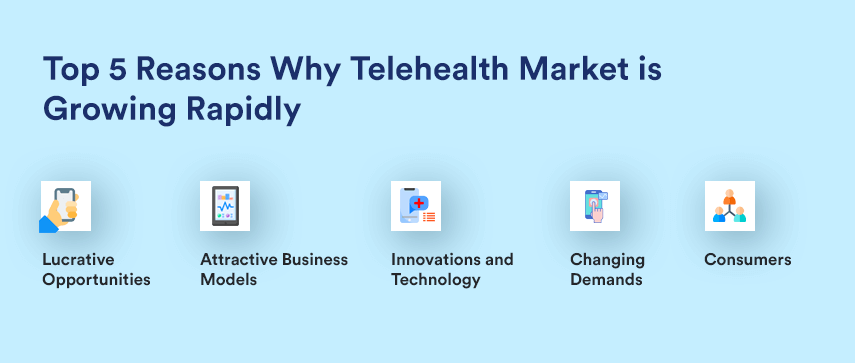
- Lucrative Opportunities:
The telehealth market is projected to reach
USD 266.8 Billion by 2026
, growing at a CAGR of 23.4% from 2018 to 2026, as the rate of telehealth service adoption is proliferating in multiple healthcare fields. Furthermore, with digital health consultation and telehealth services, healthcare providers are finding remote-based primary care cost-effective. - Attractive Business Models: Many startups and healthcare companies are ramping up in the market to provide digital healthcare services such as digital pharmacy services, online-symptom checking tools, health assessment tools, and mobile apps like online medicine ordering apps. Now virtual care is becoming more popular than non-traditional care delivered via walk-in at a physical location.
- Innovations and Technology: Researchers and technology leaders are creating healthcare tools, and digital healthcare solutions to reshape the industry as well as deliver better patient outcomes satisfying their demands. The future of healthcare is going to transform with the latest developments in healthcare technologies such as AR/VR, Artificial Intelligence, healthcare wearable technology and sensors, nanotechnology, and robotics.
- Changing Demands: The majority of the population in developed and underdeveloped countries have a strong demand for virtual healthcare services. Todays’ healthcare consumers make decisions based on the digital capabilities of medical providers, convenience, and affordability.
- Consumers: Consumers of all ages require high-quality healthcare services having latest care models, transparent communication, and cost-effective care
Leveraging telehealth and remote healthcare services can really help people to provide access to medical support anytime, anywhere in the world. It can be understood well from one of the (recent) announcements by Donald Trump. He has announced a dramatic expansion of U.S. medicare telehealth services to deal with the public health crisis and rebound stronger. He has urged the Americans to use telehealth services for treatment or virtual assistance. So, digital healthcare service is one of the convenient solutions when travel is not possible due to weather conditions and can be adapted to any situation.
So, How Telehealth Works?
Telehealth is nothing but smart usage of digital information and communication technology to manage healthcare such as mobile devices, computers, or web-based software solutions. The solution should enable the essential functions like email, video chat services, video conference to get remote care, as per the HIPAA guidelines. Virtual consultation has become a reality because of digital healthcare solutions.
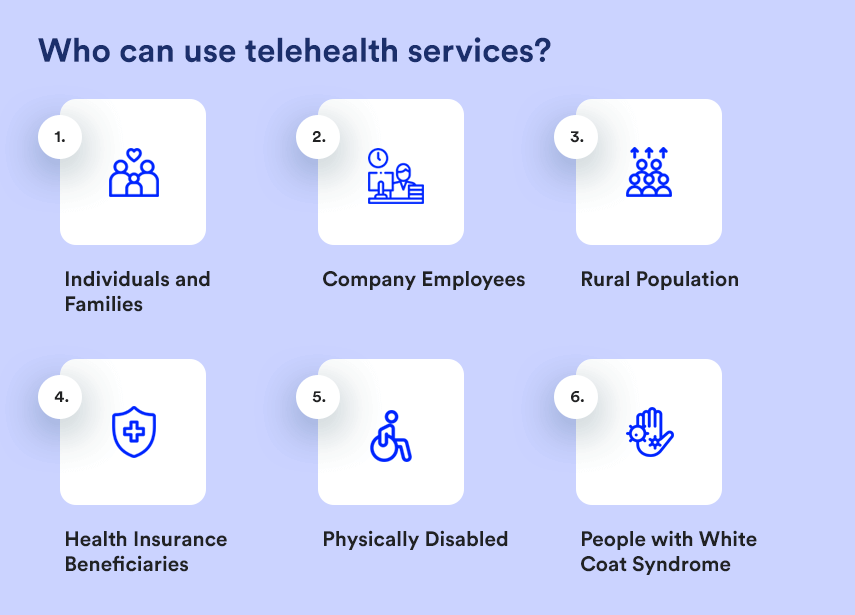
Use of Telehealth in Hospitals, Health Systems, and their Communities
Healthcare organizations are now working on expanding the telehealth capabilities to match with their patients’ needs, their expectations for digital capabilities. The providers are exploring various telehealth services for patients by strictly adhering to healthcare guidelines set by the government. The use cases of telehealth can be many. But the most frequently used are as mentioned below:
Telemedicine
Providing only medical care to patients remotely at a distance.
Digital Pharmacy
Enabling patient medication review, prescription verification, and providing medicine online.
Chronic Care Management
Equipping patients with monitoring tools at their homes to track their health signs and activities.
Sleep Disorder
Monitoring the sleep pattern, breathing, and body positions via telehealth.
Consultation
Providing healthcare information via remote specialists, counselors, or other professionals.
Telestroke
Evaluating as well as diagnosing those with acute stroke and providing therapies.
Why Telehealth is Important to Healthcare System Transformation
Optimization of telehealth services is beneficial to patients, hospitals, and healthcare systems, as it addresses all healthcare needs. It enables hospital services at home, reducing the commuting time and costs. It has changed the paradigm of healthcare and improved healthcare access for all. Let us see why it is important for all:
For Patients:
- Easy clinical care and consultation at a remote location
- Patient monitoring, diagnosis, and analysis at a distance
- More timely and immediate patient care
- Reduces the travel cost of visiting hospitals
- Enhances patient engagement and satisfaction
- Enables access to online medicine
For Healthcare Service Providers:
- Better central monitoring of medical data of patients
- Saves time of medical staff and allocate more hours to patients
- Enhanced emergency as well as intensive care services.
- Helps to become a differentiator in the market
- Improves organizational performance
- Enables better resource utilization and management
- Enhances the healthcare capacity to deliver care
- Enables easy clinical integration at any place
- Partnership and networking with other healthcare stakeholders
- Supports healthcare consumerism strategies
Although having so many advantages of telehealth services, few challenges for providers can not be avoided, such as lack of knowledge to integrate the service, resistance to adopt a new system in the organization, resource utilization, and reimbursement issues, rules, and regulations. Explanations of each challenge have already been discussed in one of our healthcare blogs. But considering the future opportunities and benefits of telehealth services, healthcare stakeholders can not resist taking advantage of the new healthcare delivery model. It is one of the important elements of the digital transformation in healthcare. It has improved the quality of care in rural areas by reducing the potential of inconvenient long-distance travel time. An integrated healthcare system has enabled affordable and value-based care at the right time and in the right place.
Final Thoughts,
Collectively, telehealth is the future of healthcare, that has laid the foundation to provide value-based virtual healthcare. Hospitals and healthcare organizations are now adopting a new model of care to provide convenient care remotely. The implementation of digital solutions will help healthcare business stakeholders to enhance their business performance. Tech-savvy individuals, younger and older, are more likely to incline towards telehealth services considering its potential to deliver outstanding healthcare outcomes as well as its convenience, affordability, and accessibility. The integration of telehealth into the healthcare system will benefit all the associated healthcare stakeholders. The quality of healthcare capabilities, clinical assessment, resource utilization, and management helps increase organizational value.
By lowering healthcare costs and improving care models, telehealth has filled significant gaps in the healthcare industry. In response to current statutory worldwide changes, telehealth has made more progress allowing patients and healthcare service providers to incorporate the service in quality care delivery. So many healthcare organizations have integrated telehealth services to provide home-based healthcare services all around the world, right now. Do you also want to incorporate telehealth services into your healthcare organization? Contact our experts now and help people save their lives across the world.
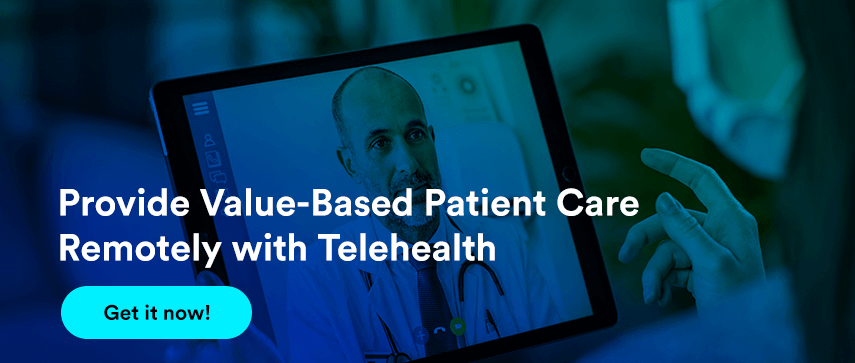
Author's Bio

Nitin Lahoti is the Co-Founder and Director at Mobisoft Infotech. He has 15 years of experience in Design, Business Development and Startups. His expertise is in Product Ideation, UX/UI design, Startup consulting and mentoring. He prefers business readings and loves traveling.


